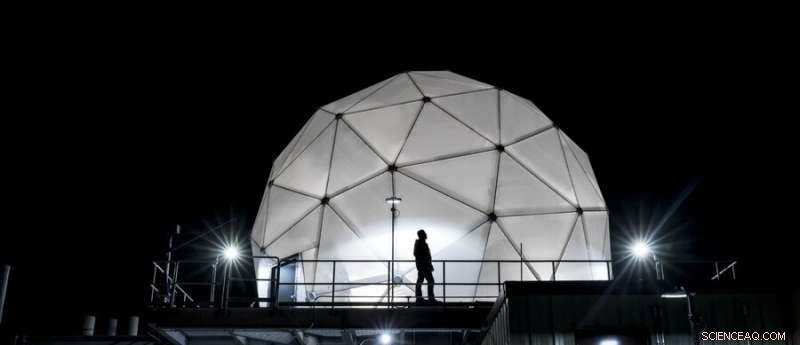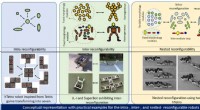Antenne muliggør avanceret satellitkommunikationstest

Radomen, der beskytter Multi-Band Test Terminal - en stor antenne på en MIT Lincoln Laboratory-bygnings tagterrasse - vises oplyst om natten. Kredit:Glen Cooper, MIT
På taget af en MIT Lincoln Laboratory-bygning sidder en 38 fod bred kuppelformet radioantennekabinet eller radom. Inde i det klimakontrollerede miljø, afskærmet fra vejret i New England, understøtter en stålkonstruktion en 20.000 pund, 20 fods diameter satellitkommunikationsantenne (SATCOM). Antennen - kaldet Multi-Band Test Terminal (MBTT) - kan rotere 15 grader i sekundet og fuldføre en enkelt omdrejning på 24 sekunder. Ved denne hastighed kan MBTT detektere og spore satellitter i medium og lav kredsløb om jorden (middel og lav refererer til den højde, hvor satellitterne kredser om jorden).
Før installationen af MBTT i 2017, var laboratoriet afhængig af en række mindre antenner til SATCOM-test, inklusive Over-the-Air Ka-band Test Terminal eller OTAKaTT. Sammenlignet med OTAKaTT-antennen med næsten otte fod i diameter, er MBTT syv gange mere følsom. Og i modsætning til sin forgænger er MBTT, som navnet antyder, designet til let at blive omkonfigureret til at understøtte flere radiofrekvensbånd (RF) brugt til militære og kommercielle satellit-SATCOM-systemer.
"Som et meget større, mere kraftfuldt og mere fleksibelt testaktiv end OTAKaTT er MBTT en game-changer for at muliggøre udviklingen af avanceret SATCOM-teknologi," siger Brian Wolf, en teknisk medarbejder i Lincoln Laboratory's Advanced Satcom Systems and Operations Gruppe.
Wolf var involveret i installationen og den indledende idriftsættelse af MBTT i 2017. Han førte derefter MBTT gennem en streng certificeringsproces med US Army Space and Missile Defense Command, afsluttet i 2019, hvilket demonstrerede, at antennens sende- og modtageydeevne var tilstrækkelig til, at den kan fungere på Wideband Global SATCOM (WGS)-systemet. WGS er en konstellation af 10 satellitter, der ejes og drives af det amerikanske forsvarsministerium, og giver høj datahastighedsforbindelse mellem forskellige punkter på Jorden. Siden 2019 har Wolf fungeret som hovedefterforsker på et projekt, der ejer MBTT, der understøtter udviklingen af den amerikanske rumstyrkes beskyttede anti-jam taktiske SATCOM (PATS)-kapaciteter.
"PATS udvikler evnen til at levere beskyttede taktiske bølgeform- eller PTW-tjenester over WGS såvel som over kommercielle transpondersatellitter og nye DoD-satellitter med dedikeret PTW-behandling ombord," siger Wolf.
Som Wolf forklarer, er en bølgeform det signal, der transmitteres mellem to modemer, når de kommunikerer, og PTW er en speciel form for bølgeform, der er designet til at give meget sikker, jamming-resistent kommunikation. Jamming refererer til, når kommunikationssignaler forstyrres - enten ved et uheld af venlige styrker (som f.eks. kan have fejlkonfigureret deres SATCOM-udstyr og sender med den forkerte frekvens) eller bevidst af modstandere, der søger at forhindre kommunikation. Lincoln Laboratory begyndte at udvikle PTW i 2011, hvilket bidrog til det indledende design og systemarkitektur. I årene siden har laboratoriet deltaget i prototype- og testbestræbelser for at hjælpe industrien med at modne modemer til behandling af bølgeformen.
"Our prototype PTW modems have been fielded to industry sites all over the country so vendors can test against them as they develop PTW systems that will be deployed in the real world," says Wolf. The initial operating capability for PTW services over WGS is anticipated for 2024.
Staff originally conceived the MBTT as a test asset for PTW. Directly underneath the MBTT is a PTW development lab, where researchers can run connections directly to the antenna to perform PTW testing.
One of the design goals for PTW is the flexibility to operate on a wide range of RF bands relevant to satellite communications. That means researchers need a way to test PTW on these bands. The MBTT was designed to support four commonly used bands for SATCOM that span frequencies from 7 GHz to 46 GHz:X, Ku, Ka, and Q. However, the MBTT can be adapted in the future to support other bands through the design of additional antenna feeds, the equipment connecting the antenna to the RF transmitter and receiver.
To switch between the different supported RF bands, the MBTT must be reconfigured with a new antenna feed, which emits signals onto and collects signals from the antenna dish, and RF processing components. When not in use, antenna feeds and other RF components are stored in the MBTT command center, located underneath the main platform of the antenna. The feeds come in a range of sizes, with the largest registering six feet in length and weighing nearly 200 pounds.
To swap out one feed for another, a crane inside the radome is used to lift up, unbolt, and remove the old feed; a second crane then lifts the new feed up into place. Not only does the feed on the front of the antenna need to be replaced, but all of the RF processing components on the back of the antenna—such as the high-power amplifier for boosting satellite signals and the downconverter for converting RF signals to a lower frequency more suitable for digital processing—also need to be replaced. A team of skilled technicians can complete this process in four to six hours. Before scientists can run any tests, the technicians must calibrate the new feed to ensure it is operating properly. Typically, they point the antenna onto a satellite known to broadcast at a specific frequency and collect receive measurements, and point the antenna straight up into free space to collect transmission measurements.
Since its installation, the MBTT has supported a wide range of tests and experiments involving PTW. During the Protected Tactical Service Field Demonstration, a PTW modem prototyping effort from 2015 to 2020, the laboratory conducted tests over several satellites, including the EchoStar 9 commercial satellite (which offers broadband SATCOM services, including satellite TV, across the country) and DoD-operated WGS satellites. In 2021, the laboratory used its PTW modem prototype as the terminal modem to conduct an over-the-air test of the Protected Tactical Enterprise Service—a ground-based PTW processing platform Boeing is developing under the PATS program—with the Inmarsat-5 satellite. The laboratory again used Inmarsat-5 to test a prototype enterprise management and control system for enabling resilient, uninterrupted SATCOM. In these tests, the PTW modem prototype, flying onboard a 737 aircraft, communicated through Inmarsat-5 back to the MBTT.
"Inmarsat-5 provides a military Ka-band transponded service suitable for PTW, as well as a commercial Ka-band service called Global Xpress," explains Wolf. "Through the flight tests, we were able to demonstrate resilient end-to-end network connections across multiple SATCOM paths, including PTW on military Ka-band and a commercial SATCOM service. This way, if one satellite communications link is not working well—maybe it's congested with too many users and bandwidth isn't sufficient, or someone is trying to interfere with it—you can switch to the backup secondary link."
In another 2021 demonstration, the laboratory employed the MBTT as a source of modeled interference to test PTW over O3b, a medium-Earth-orbit satellite constellation owned by the company SES. As Wolf explains, SES provided much of their own terminal antenna equipment, so, in this case, the MBTT was helpful as a test instrument to simulate various types of interference. These interferences ranged from misconfigured users transmitting at the wrong frequencies to simulation of advanced jamming strategies that may be deployed by other nation states.
The MBTT is also supporting international outreach efforts led by Space Systems Command, part of the U.S. Space Force, to extend the PATS capability to international partners. In 2020, the laboratory used the MBTT to demonstrate PTW at X-band over SkyNet 5C, a military communications satellite providing services to the British Armed Forces and coalition North Atlantic Treaty Organization forces.
"Our role comes in when an international partner says, "PTW is great, but will it work on my satellite or on my terminal antenna?'" explains Wolf. "The SkyNet test was our first using PTW over X-band."
Connected via fiber-optic links to research facilities across Lincoln Laboratory, the MBTT has also supported non-PTW testing. Staff have tested new signal processing technology to suppress or remove interference from jammers, new techniques for signal detection and geolocation, and new ways of connecting PTW users to other Department of Defense systems.
In the years ahead, the laboratory looks forward to performing more testing with more user communities in the Department of Defense. As PTW reaches operational maturity, the MBTT, as a reference terminal, could support testing of vendors' systems. And as PTS satellites with onboard PTW processing reach orbit, the MBTT could contribute to early on-orbit checkout, measurement, and characterization.
"It's an exciting time to be involved in this effort, as vendors are developing real SATCOM systems based on the concepts, prototypes, and architectures we've developed," says Wolf. + Udforsk yderligere
Flight testing validates waveform capability
Denne historie er genudgivet med tilladelse fra MIT News (web.mit.edu/newsoffice/), et populært websted, der dækker nyheder om MIT-forskning, innovation og undervisning.
 Varme artikler
Varme artikler
-
 AI-drevne sko låser op for hemmelighederne bag din sålKredit:CC0 Public Domain Forskere ved Stevens Institute of Technology har udviklet en AI-drevet, smart indersål, der øjeblikkeligt forvandler enhver sko til et bærbart ganganalyselaboratorium. Ar
AI-drevne sko låser op for hemmelighederne bag din sålKredit:CC0 Public Domain Forskere ved Stevens Institute of Technology har udviklet en AI-drevet, smart indersål, der øjeblikkeligt forvandler enhver sko til et bærbart ganganalyselaboratorium. Ar -
 En ramme til at evaluere og sammenligne selvrekonfigurerbare robotsystemerKredit:Tan et al. Selvrekonfigurerbare robotter (SRRer), der automatisk kan ændre form og tilpasse sig deres omgivende miljø, har for nylig tiltrukket sig stor interesse inden for robotforskningsm
En ramme til at evaluere og sammenligne selvrekonfigurerbare robotsystemerKredit:Tan et al. Selvrekonfigurerbare robotter (SRRer), der automatisk kan ændre form og tilpasse sig deres omgivende miljø, har for nylig tiltrukket sig stor interesse inden for robotforskningsm -
 amerikanske seniorer opfylder drømme, bekæmp depression med virtual realityNidia Silva prøver en virtual reality-oplevelse i Little Havana-kvarteret i Miami, Florida Nidia Silva havde aldrig realiseret sin drøm om at svømme med delfiner, indtil en NGO i Miami gav hende e
amerikanske seniorer opfylder drømme, bekæmp depression med virtual realityNidia Silva prøver en virtual reality-oplevelse i Little Havana-kvarteret i Miami, Florida Nidia Silva havde aldrig realiseret sin drøm om at svømme med delfiner, indtil en NGO i Miami gav hende e -
 Intel kaster tredje patch til kamp mod MDS GoliathKredit:CC0 Public Domain Hvad skal en chipgigant gøre? ZombieLoad vil ikke dø, og det er ikke tilladt. Intel har tvunget en tredje patch ud, sagde rapporter. Joel Hruska ind ExtremeTech onsdag
Intel kaster tredje patch til kamp mod MDS GoliathKredit:CC0 Public Domain Hvad skal en chipgigant gøre? ZombieLoad vil ikke dø, og det er ikke tilladt. Intel har tvunget en tredje patch ud, sagde rapporter. Joel Hruska ind ExtremeTech onsdag
- Virgin Galactic siger, at den vil flyve italienske luftvåbenforskere
- Forskere aflytter vulkanske rumlen for at forudsige udbrud
- Sådan beregnes initialkoncentrationer
- Forskere belyser området for mikroskopi med nanopartikel-buckyswitch
- Jobdeling kan øge antallet af kvinder i senior videregående uddannelser
- Hvordan plantevirus kan bruges til at afværge skadedyr og holde planter sunde


